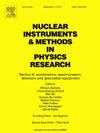应用于质子治疗设备的无损探测仪的设计与研制
IF 1.4
3区 物理与天体物理
Q3 INSTRUMENTS & INSTRUMENTATION
Nuclear Instruments & Methods in Physics Research Section A-accelerators Spectrometers Detectors and Associated Equipment
Pub Date : 2025-04-11
DOI:10.1016/j.nima.2025.170514
引用次数: 0
摘要
研制了一种具有光信号采集功能的非破坏性离子收集电离剖面监测仪(IPM)。这种无损探测仪可以实现对na级光束强度的实时轮廓测量。对于质子治疗装置的光束参数,本文介绍了IPM设计的一些考虑,包括信号产额估计、空间电荷效应和初始动量评估。提出了一种优化的电极电位配置来调节IPM引导场的聚焦能力,以减小信号离子的轨迹偏差,提高测量精度。IPM已经在低能质子束线中进行了测试,可以调整到质子治疗设备的等效工作条件。实验结果表明,在质子治疗设施中,它可以作为一种无损探测器。本文章由计算机程序翻译,如有差异,请以英文原文为准。
Design and development of a nondestructive detector applied to a proton therapy facility
A nondestructive ion-collection ionization profile monitor (IPM) with optical-signal acquisition has been developed for a proton therapy facility. This kind of nondestructive detector can make the real time profile measurements at nA-level beam intensity possible and efficient. For the beam parameters of a proton therapy facility, this paper describes some IPM design considerations, including signal yield estimation, space charge effects, and initial momentum evaluation. An optimized electrode potential configuration was proposed to adjust the focusing ability of the IPM guiding field to reduce the trajectory deviation of the signal ions and enhance measurement accuracy. The IPM has been tested in a low-energy proton beamline, which can be tuned to an equivalent working condition of a proton therapy facility. The experimental results are presented and show the potential to be used as a nondestructive detector in a proton therapy facility.
求助全文
通过发布文献求助,成功后即可免费获取论文全文。
去求助
来源期刊
CiteScore
3.20
自引率
21.40%
发文量
787
审稿时长
1 months
期刊介绍:
Section A of Nuclear Instruments and Methods in Physics Research publishes papers on design, manufacturing and performance of scientific instruments with an emphasis on large scale facilities. This includes the development of particle accelerators, ion sources, beam transport systems and target arrangements as well as the use of secondary phenomena such as synchrotron radiation and free electron lasers. It also includes all types of instrumentation for the detection and spectrometry of radiations from high energy processes and nuclear decays, as well as instrumentation for experiments at nuclear reactors. Specialized electronics for nuclear and other types of spectrometry as well as computerization of measurements and control systems in this area also find their place in the A section.
Theoretical as well as experimental papers are accepted.

 求助内容:
求助内容: 应助结果提醒方式:
应助结果提醒方式:


